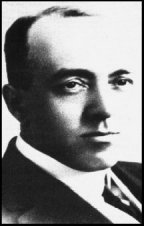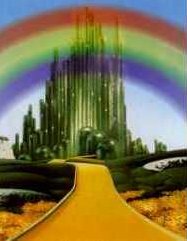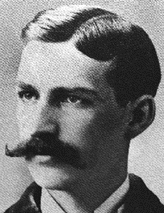This brief article is in
response to Dale R. Broadhurstís recent series of exhibits John Carter
and the Sword of Theosophy - Revisited published on the internet by
Bill Hillman at ERBzine. I believe that many of the questions raised in
his interesting pages may be answered at least in part by a reference to
Edgar Rice Burroughsí connection with L. Frank Baum of The Wonderful
Wizard of Oz fame.

Baum was a practicing theosophist and a close friend of Edgar
Rice Burroughs -- at least close enough to recommend him in 1917 to membership
in the Uplifters, a club of California businessman founded by Baum in 1914.
It had been the practice of the Burroughs family to winter in California,
usually starting in September, from at least the year 1913. Ed most likely
met Baum during one of these extended periods*
because by 1917 he felt that he knew him well enough to recommend his membership
in the Uplifters, even though the Burroughs did not move to Tarzana until
January 1919. That Ed was already a long-time a fan of the Oz series is
proven from his early Minidoka,
which includes a nod to Baum in the introduction as well as in the whimsical
contents of this childrenís story.
Perhaps the most thorough documentation of Baumís connection
with theosophy was given in David B. Parkerís "Oz: L. Frank Baumís Theosophical
Utopia," a paper delivered at the Kennesaw Academic forum, April 1996.
In his study, Parker presents a brief history of the various critical treatments
of Oz over the years and cites Baumís friendly theosophical musings as
the editor of the Aberdeen (South Dakota) Saturday Pioneer newspaper in
1890-91. An article by John Algeo, titled "A Notable Theosophist: L. Frank
Baum" was published in the journal of the Theosophical Society in America
announcing Baum and his wifeís admission into the membership of the Chicago
branch of the Theosophical Society on September 4, 1892.
Robert R. Barrett notes that the manuscript of Minidoka
was written during the 1901-1904 period when Burroughs and his wife were
involved with his brotherís gold mining enterprise in Idaho. Barrett writes,
"Burroughs may well have been inspired by L. Frank Baumís introduction
to The Wonderful
Wizard of Oz (1900); why else would he have subtitled this story
"An Historical Fairy Tale?" (Burroughs, 8).
Actually, Baumís introduction to the Wizard of Oz means
to contrast his own "modernized fairy tale" with the older "historical"
fairy tale. He gives examples of the later as Grimm and Anderson and goes
on to write:
"Yet the old-time fairy tale, having serves for generations,
may now be classed as "historical" in the childrenís library; for the time
has come for a series of newer "wonder tales" in which the stereotyped
genie, dwarf and fairy are eliminated, together with all the horrible and
blood-curdling incidents devised by their authors to paint a fearsome moral
to each tale. Modern education includes morality; therefore the modern
child seeks only entertainment in its wonder-tales and gladly dispenses
with all disagreeable incidents.
Having this thought in mind, the story of The Wonderful
Wizard of Oz was written solely to pleasure children of today. It aspires
to being a modernized fairy tale, in which the wonderment and joy are retained
and the heart-aches and nightmares are left out." (Baum, 5).
Thus, itís not exactly certain what Burroughs meant by
"historical" unless he intended that he was writing in that older form
which Baum clearly rejects in his introduction. Even more confusing is
the fact that Baum does indeed include a host of dwarf-like characters
and blood-curdling incidents in his Oz series, in fact, his pantheon of
strange peoples and monsters is very similar to those later created by
Burroughs. About the only "modern" elements one may find in Baum is the
fact that his fantasies refer to American sites as does Burroughs in his
Minidoka as well as in many later adventures on strange worlds.
One need not go so far afield as the confusing tomes of
Madame Blavatsky to find a theosophical connection in the writing of Burroughs
-- even though a perusal of the chapter titles of her works alone read
like the themes of ERB stories. The wide-read Burroughs no doubt was familiar
with her work since it was so popular in his early years, but, true to
his nature, if he was influenced by her writing at all, it would have been
to reverse her fanciful findings rather than be directly inspired by them.
No one would ever suggest that his general disinterest in any kind of organized
religion would be followed by his being taken by the mumbo jumbo of such
a strange cult as the theosophists.
However, friend Baum was an ardent theosophist, and no
doubt bent Edís ear with many of these flights of fancy and outlandish
theories about the origins of mankind and the ancient history of the world.
He also must have explained to him how theosophy was embedded in his own
Oz series, which I imagine Ed would have found highly amusing but hardly
a model to follow in his own work. Most of ERBís mystical flights tend
to be tongue-in-cheek -- increasingly so in his later work, especially
in the Venus series. A careful reading of his entire oeuvre demonstrates
only a thin scaffolding of mystery and mystification before he cuts to
the chase of love and adventure. His infrequent long digressions into explanations
of mythic origins of a certain race or world are never meant to be taken
seriously as the tenets of a theosophical system but are merely structures
to weave a entertaining yarn.
Itís fun to speculate on ERBís influences because there
are so many. Yet, the man himself was a great inventor with one of the
most fertile minds in imaginative literature. Burroughs is more than a
synthesis of his wide reading. He himself is the magician of his realm,
pulling peoples, creatures, and entire worlds out of his hat before our
amazed eyes. He did this for over forty years, traveling through the normal
three periods of artistic creation: Early Works (influenced by others,
yet marked by the originality of his personal style); a Middle Period of
maturity in which he refined his particular characteristics and wrote his
masterpieces; and Late Works in which he moved away from his easy success
to try his hand at new ideas and invented new worlds to conquer.
Having written all this -- the usual disavowal of any
overwhelming influence on The Master -- let me say that Baum was a charming
man who was genuinely interested in writing childrenís literature. Burroughs
was without question charmed by both the man and by his writing and would
have felt honored to be his friend. I would guess that Ed was fascinated
with Baumís success in publishing and probably picked his mind more about
practical matters of selling and expanding his writing empire rather than
getting into serious theosophical discussions. Yet everything seemed to
rub off on Burroughs; he was able to take in a great amount of information
and turn it over in his imagination to come up with new twists that have
delighted readers for nearly a hundred years.
Edís personal relationship with Baum was probably friendly
but not profound. As early as 1917, the very year that Burroughs came into
the Uplifters, Baum was already seriously ill with a series of operations
to follow, and he became bedridden for the rest of his life. Baum died
on May 6, 1919, and the funeral was held at Forest Lawn Memorial Park in
nearby Glendale. Ed was writing Under the Red Star at the
time, an anticommunist satire set in the distant future of America. The
views presented in this piece are overtly patriotic, which was typical
of his Republican politics, but also graphically Christian, which is definitely
atypical of his writing. There is even a sympathetic mention of a figure
of Jesus Christ on the cross carved on ivory from an elephant tusk! Itís
not theosophy, but it does show that Burroughs was still experimenting
with personal philosophy in his writing, which quickly returned to a more
typical satirical view of religion in general.
There is, to be sure, a definite Baum-Burroughs connection
but with only the most tenuous link to theosophy. The difficulty with Burroughs,
which does provide us with an intriguing series of questions, is related
to his fecundity of creation. He wrote so very much and did have syncretic
inclinations -- even linking his own multiple series at times -- yet the
problem of coming up with a logical system to explain all the details of
his many inventive worlds must always be met with, to quote Winston Churchill,
"a riddle wrapped in a mystery inside an enigma." His only partly systematic
worlds have rambling mixtures of fact and fantasy like theosophical meanderings,
yet these tangles are related to the flashes of his inventive imagination
rather than some template of an secret, philosophical complex. He was willing
to throw out something new and speculative rather than confining himself
to a hard logic that tied up every loose string of conception. Thus we
wonder about the intriguing, undisclosed details, such as the use or non-use
of telepathy on Barsoom, the hatching of a combination of Martian and human
eggs, the exact taxonomy of plant men -- among a host of other conundrums.
At times, Burroughs sounds like a theosophist, and thus
gives rise to speculation. I believe that the link with Baum is a valid
one, but not the only one which may have led him into the thickets of theosophy.
It is certain that Burroughs was not stuck in there, no matter what sticky
goo may have rubbed off from either Baum or Blavatsky. Ed was too protean
for that. He created systems of his own, and theosophy had to wait in line
for his subconscious to process and decant a portion of its brew according
to his need in his next novel. Again, I must say, that it seems that nothing
ever came out of Edís imagination from his reading or conversations with
others that was not set on its head, topsy-turvy, to be given a Burroughsian
twist into not Oz but Otz. Heaven is hell for travelers down the river
Iss. Dante is conjured as often as Blavatsky, but the mixture is always
pure Burroughs.
Burroughsí inventive output over his 40 years as an author
is remarkable enough with his 80 plus novels and stories, yet the vast
(there is no other word for it) number of his characters, creatures, and
worlds have given rise to entire dictionaries just to keep track of the
enormous wealth of names and places, most of which are extremely inventive,
employing the use of a host of languages from both East and West. These
titles, names, locations, etc. are as extensive as the Hindu pantheon of
gods, and are so suggestive of a familiarity with nearly every world religion,
that speculation easily arises about some sort of theosophical link, yet
every indication from his biographers tells us that Ed was not a deep thinker,
just an amazing storyteller and word crafter who found the name or title
that sounded right for each man, woman, or denizen of his worlds. It was
not so much the matter of a philosophical system as having an exceptionally
good ear for the precise sound and effect of words.
Of course, that does not mean that one could not easily
construct a theosophical system out of ERBís writings. They are certainly
complex enough in the multitude of details, and most of his characters
can bear the weight of archetypal assimilation. In fact, his most famous
character, Tarzan, has become a symbol for the wild man of nature known
around the entire world. The main problem with constructing such a pantheon
is not diversity but depth, for, like Baum, Burroughs is considered to
be a writer of literature for children or adolescents, so his work today
is considered as examples of dated and blushingly romantic sword and sorcery
or proto-science fiction.
Like Baum, Burroughs still has his adepts -- his fans
-- or I would not be writing this article. His writing is still engaging
to me, and part of the fun is playing with the great wealth of possibilities
contained in his fantastic characters and images from many worlds beyond
this familiar one.
*
Taliaferro indicates the winter of 1916 for this meeting
.

Bibliography
Baum, L. Frank, The Wonderful Wizard of Oz, Harper/Collins, 1987
Burroughs, Edgar Rice, Minidoka, 937th Earl of One Mile Series M,
Dark Horse Comics, Inc., 1998
Taliaferro, John, Tarzan Forever: The Life of Edgar Rice Burroughs,
Creator of Tarzan, Scribner, 1999.

Internet Resources
Dale R. Broadhurst's Sword
of Theosophy Series
 Part I: John Carter: Sword of Theosophy Revisited
Part I: John Carter: Sword of Theosophy Revisited
 Part II: Lupoff of Mars: The Quest for Gullivar Jones Carter
Part II: Lupoff of Mars: The Quest for Gullivar Jones Carter
 Part III: ERB: Search for Ultimate Answers
Part III: ERB: Search for Ultimate Answers
From the Broadhurst Library:
A Source for ERB?
 William Scott-Elliot's The Story of Atlantis The Lost Lemuria ~ Part
1
William Scott-Elliot's The Story of Atlantis The Lost Lemuria ~ Part
1
 William Scott-Elliot's The Story of Atlantis The Lost Lemuria ~ Part
2
William Scott-Elliot's The Story of Atlantis The Lost Lemuria ~ Part
2
Edgar Rice Burroughs
 The Nkima Chattering from the Shoulder Articles by David Adams
The Nkima Chattering from the Shoulder Articles by David Adams
 Religious Themes in the Novels of Edgar Rice Burroughs by Robert
B. Zeuschner
Religious Themes in the Novels of Edgar Rice Burroughs by Robert
B. Zeuschner
 ERB & LFB: THE WIZARDS OF CALIFORNIA by David Adams
ERB & LFB: THE WIZARDS OF CALIFORNIA by David Adams
 Minidoka: ERB C.H.A.S.E.R. Encyclopedia
Minidoka: ERB C.H.A.S.E.R. Encyclopedia
 Edgar Rice Burroughs Bio Timeline by Bill Hillman
Edgar Rice Burroughs Bio Timeline by Bill Hillman
L. Frank Baum and Oz
 E-Text Editions of Books by L. Frank Baum
E-Text Editions of Books by L. Frank Baum
 Jim's Wizard of Oz Criticims Page
Jim's Wizard of Oz Criticims Page
 Oz: L. Frank Baum's Theosophical Utopia by David B. Parker
Oz: L. Frank Baum's Theosophical Utopia by David B. Parker
A Faculty Colloquium Speech given at Kennesaw State University, 1996.
 Eric's Wonderful Wizard of Oz Website
Eric's Wonderful Wizard of Oz Website
 Jim's Ozzy Links Page
Jim's Ozzy Links Page
 Nate Barlow's Wonderful Wizard of Oz FAQ List
Nate Barlow's Wonderful Wizard of Oz FAQ List
 Piglet Press Tour Guide to The Wonderful Wizard of Oz
Piglet Press Tour Guide to The Wonderful Wizard of Oz
 Wendy's Wonderful Wizard of Oz Complete Directory
Wendy's Wonderful Wizard of Oz Complete Directory
 "The Wonderful Wizard of Oz: Parable on Populism," by Henry M. Littlefield
"The Wonderful Wizard of Oz: Parable on Populism," by Henry M. Littlefield
 The Spirituality of Oz
The Spirituality of Oz
 The Rise and Fall of Oz as a "Parable on Populism" by David B. Parker
The Rise and Fall of Oz as a "Parable on Populism" by David B. Parker
 Oz Reference Library
Oz Reference Library
 Wizard of Allegory
Wizard of Allegory







![]()
![]()
